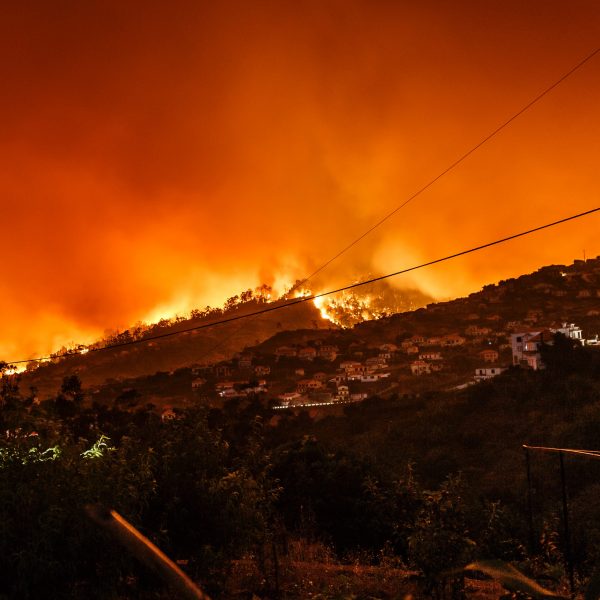Bushfire trauma puts schooling at risk

Disasters don’t end when the debris is cleared and buildings are rebuilt. The trauma and disruption echoes on for people caught up in the mayhem and suffering.
And for children, the fallout can be particularly pernicious, interrupting their normal development and potentially undermining their future chances in life.
This vulnerability in children has been starkly highlighted in new research on Australia’s tragic 2009 Black Saturday bushfires in Victoria, published in the journal Child Development. It shows that even four years on from the fires that killed 173 people, primary school children from the most affected areas were significantly more likely than their peers to be lagging in both reading and maths.
“We knew from our ongoing work in the Black Saturday communities that anecdotally the school performance of kids was suffering, but there was no data to back that up,” says Professor Lisa Gibbs from the University of Melbourne’s School of Population and Global Health.
“But we now have the data and a clear message that we need to be on the front foot in providing interventions to support ongoing learning in the wake of disasters.”
Close monitoring needed
Clinical neuropsychologist and co-researcher, Jane Nursey from Phoenix Australia – Centre for Posttraumatic Mental Health at the University of Melbourne, says the results are a “wake up call.”
“Children exposed to severe trauma and disaster are at risk of falling behind in the classroom, even years down the track, and we need to closely monitor them, not only for general wellbeing, but also with a close lens on numeracy and reading,” says Ms Nursey.
With the children from the study now in high school, Ms Nursey says they should be a key priority for learning support to help those lagging behind to catch up.
Professor Gibbs has for years been leading research into the long-term impact of trauma from Black Saturday. On that day in February, bushfires in rural Victoria, fanned by 100-kilometre winds and temperatures over 40°C, burnt out over 4000 square kilometres and totally destroyed two townships.
Based on over 1000 surveys, the earlier Beyond Bushfires study she led found that three and even five years on, rates of mental health disorders in communities that experienced the fires were sometimes twice that of the general population.
Before and After TEST DATA
But assessing whether the disaster had affected children’s school performance seemed at first a difficult and time-consuming undertaking until she realised the data already existed.
Professor Gibbs is director of the University’s Jack Brockhoff Child Health and Wellbeing Program, and one of their research partners is Victoria’s Department of Education and Training that is responsible for collecting the State’s school NAPLAN tests; NAPLAN is an annual nationwide assessment of literacy and numeracy taken by students in years 3, 5, 7 and 9.
“It’s difficult to collect useful data around a disaster because we don’t know when they are going to happen and it is chaotic afterwards. But I realised there was already some ready-made ‘before and after’ data. It was a huge opportunity to conduct valuable research without bothering affected families,” says Professor Gibbs.
By looking at the data for kids who were in first grade (about six years old) at the time of the fire, the researchers could compare the third and fifth grade NAPLAN results of those children attending schools in communities badly affected by the fires with those of children in less affected areas.
Using a system developed by the University’s Centre for Disaster Management and Public Safety, the researchers were able to categorise the affected 1201 primary schools into areas of high, moderate, and low impact based on the extent of damage and loss of life in each area. That gave them a cohort of 24,642 children, of which 1285 were from 78 highly impacted schools.
When they analysed the data, they found there was very little difference in school performance when it came to writing, grammar and spelling. But in reading and numeracy, children from the highly impacted areas were significantly more likely to show slower development.
Reading and Numeracy vulnerable
“These children weren’t progressing as well as their peers,” says Professor Gibbs, “even four years after the event.”
The initial analysis was limited to identifying statistical patterns rather than quantifying the extent of the performance difference, but Professor Gibbs says the analysis shows that the extent of the education delays was significant, even after controlling for social factors like the education background of parents.
The study didn’t include students who moved to different schools between grades 3 and 5, but Professor Gibbs says that given relocation was more common among families who lost property in the fire, these children are also likely to be at more risk of having had their learning affected.
The research doesn’t explain exactly why individual children from highly impacted areas were more likely to fall behind. It might be partly due to the disruption that occurred – some schools were in temporary accommodation for up to two years.
But it’s also likely to reflect trauma, which is known to impact the development of children. Indeed, Ms Nursey points out that trauma is particularly detrimental to cognitive skills that underlie the development of reading and numeracy.
“Both reading and numeracy rely heavily on working memory and speed of processing, as well as higher level executive skills like planning, making these tasks more cognitively demanding and therefore more susceptible to trauma impacts, than the writing or spelling tasks.” she says.
“Generally speaking, the younger the child is at the time of exposure the greater the risk, but older adolescents can also be impacted, especially if they have had previous exposure to trauma and/or have an adverse family environment.
“Trauma changes the brain’s developmental processes and in turn these changes can adversely impact all areas of a child’s development – and often these impacts might not be apparent until some years down the track.”
But, whether it is trauma or severe disruption to their lives, some disaster-affected children end up being ‘unavailable’ for learning in the classroom. They develop attention problems, become distracted, and can have difficulty managing their emotions, easily becoming upset and angry, all of which make it more difficult for them to learn.
Extending study to later school years
“Given early primary school is a crucial time for consolidating academic building blocks like reading and numeracy, this makes primary school children particularly vulnerable to these academic impacts.”
The researchers now want to continue their study into the later school years of affected children.
“We still know very little about the longer-term impacts of disaster on children’s learning as most studies have only looked at performance one-to-three years after an event.” says Ms Nursey.
“While our study extends this to four years, it will be really important to track these children over time into adolescence. Do these children catch up over time or do they fall further behind? Are there other impacts further down the track that are not apparent at this stage of their development?
“This has significant implications in terms of providing appropriate interventions to help these children achieve not only good academic outcomes but good life outcomes.”
This article was first published on Pursuit. Read the original article.
Popular

Workforce
Quality
Research
When did it start to go wrong?
2025-12-18 08:00:46
by Fiona Alston

Economics
Policy
Quality
Provider
Research
Is your service ready? Key updates to Queensland kindergarten funding in 2026
2025-12-17 07:00:15
by Fiona Alston

Quality
Workforce
Practice
Research
Let’s not lose the word 'Children'
2025-12-18 07:45:13
by Fiona Alston















